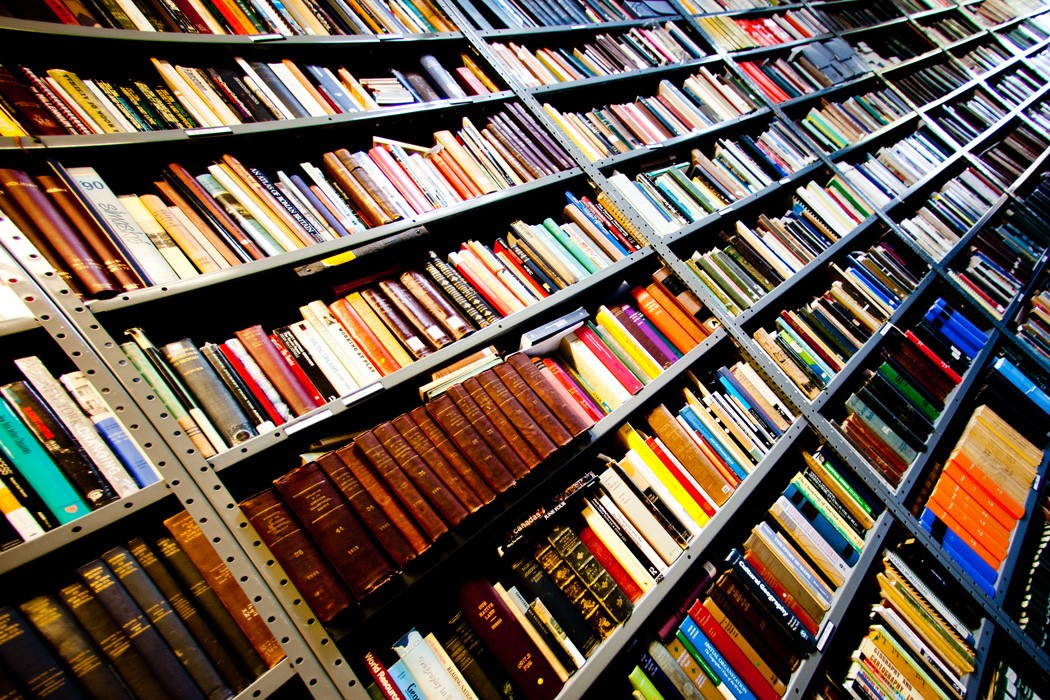I am unpacking my library. Yes, I am. The books are not yet on the shelves, not yet touched by the mild boredom of order. I cannot march up and down their ranks to pass them in review before a friendly audience. You need not fear any of that.
Walter Benjamin, “Unpacking My Library”
Megan Shaw Prelinger and Rick Prelinger have found a way to make unpacking their library a way of life, resisting the order imposed by Melvil Dewey or the Library of Congress by finding a way to live in a disorder that is not arbitrary, but unfinished—a kind of order-in-process. Walter Benjamin would have felt at home amidst the clutter of overflowing cardboard boxes that is the “staging area” of the Prelinger Library in San Francisco. The website describes the library as “an appropriation-friendly, browsable collection of approximately 40,000 books, periodicals, printed ephemera and government documents,” and this private/public library is a model for the negotiation between the promise of digital technology on the one hand, and the joys of browsing and the preservation concerns attendant on our relationship with actual books, the relics of a print culture that many worry is eroding from its former position of influence.Rick Prelinger comes by his reputation as a renegade archivist honestly. He spent much of the 1980s travelling the United States collecting unwanted 16 mm “ephemeral films” from schools and libraries. These included industrial films, safety videos, social-hygiene messages, among other topics, and he is given credit for saving the entire genre from extinction. The collection became known as the Prelinger Archives and consisted of more than 48,000 films by 2002 when Rick and Megan sold it to the Library of Congress. The library project began simply enough as the result of two independent scholars and archivists getting married and merging their collections.
There is at least one significant precedent for the Prelinger Library. The Warburg Institute Library historically shared certain key features with theirs, although the Prelingers maintain that the influence is indirect.
Aby Warburg was born into a wealthy Hamburg banking family in 1866. At the age of thirteen he made a deal with his younger brother Max that was to shape both their lives. He agreed to rescind his right, as the eldest son, to the family banking business if his brother would buy him all the books he wanted for the rest of his life.
[Warburg] agreed to rescind his right, as the eldest son, to the family banking business if his brother would buy him all the books he wanted for the rest of his life.
Warburg’s book collection from its inception focused on the exploration of the life of the symbol in culture, specifically how certain symbols survived from pagan antiquity to be transformed by the needs of later ages. His doctoral dissertation on Botticelli’s “The Birth of Venus” explored the ways symbols of Dionysian chaos are replicated in Botticelli’s work. It formed the foundation of his life’s work which was to shape the discipline of modern iconology.
Warburg rejected the library classification schemes that were developed during the nineteenth century, such as the Dewey Decimal system. He needed his library to be responsive to the concerns in his research, and as these shifted the relationships between his books shifted as well. Beginning with his work on Botticelli, Warburg’s library expanded at the rate of about six hundred books per year. His interest was initially to paint as full a picture of Renaissance culture as possible to accomplish a thorough “reading” of Botticelli’s work in its historical context.
A trip to the American southwest in 1895-1896 served to broaden Warburg’s interests. He studied elements of serpent symbolism and ritual that survived among Hopi communities and became fascinated with the way these traditional symbols survived even in fully modernized cultures. From this point his library would swell enormously to incorporate all aspects of cultural development and its relationship with pagan antiquity. He would include everything from books in conventional academic disciplines like archaeology, ethnology, art history, philology, and psychology to astrology, alchemy and numerology, railway timetables, telephone books, lottery books, and old almanacs. In his desire to perceive, as Alberto Manguel puts it in The Library at Night “the essential forces of the human mind and its history,” everything was relevant, and the shape of his thinking could not be confined to one academic discipline.
It was so important to Warburg to maintain an open flow of association between one idea and the next, one book and its neighbor, that when the library was eventually established in a building of its own next to his home in Hamburg he had an oval reading room designed for it so that the chain of associations between books would have, according to Manguel, “a space uninterrupted by sharp angles, in which they could retain endless mobility”:
As Warburg imagined it, a library was above all an accumulation of associations, each association breeding a new image or text to be associated, until the associations returned the reader to the first page. For Warburg, every library was circular.
Warburg dedicated his library to Mnemosyne, the Greek goddess of memory and mother of the Muses. This was entirely appropriate as its organization, as a reflection of Warburg’s intellect, had more in common with the imaginative assemblage typical of poetic composition than with the logical empiricism that guided the work of most scholars during Warburg’s lifetime. The library was opened to other scholars in the early 1920s, and in 1933, four years after Warburg’s death, it was moved to the University of London where it formed the core of the Warburg Institute, an interdisciplinary research center.
The Prelinger Library shares many features with Aby Warburg’s library, but it has some significant differences as well. Whereas the organizational principle of Warburg’s library was the circle, the Prelinger Library is more linear, a feature rooted in its emphasis on locality. The library consists of six rows of 15-foot-high metal shelving creating three aisles, and as Megan describes it on the library’s website, its contents “cohere around four constant threads: landscape and geography; media and representation; historical consciousness; and political narratives from beyond the mainstream.”
The organization of the material on the shelves is reminiscent of the address on a letter described at the end of the first act in Thornton Wilder’s 1938 play Our Town, “Jane Crofut; The Crofut Farm; Grover’s Corners; Sutton County; New Hampshire; United States of America; Continent of North America; Western Hemisphere; the Earth; the Solar System; the Universe; the Mind of God…”
Megan writes in an article on the organization of the library, “The library’s flow of subject matter starts with where we are, with the local” and, just like the address on Jane Crofut’s letter, “subjects move from the place-based, the concrete, the tangible, in the first three rows, toward the etherized, the abstract, and the theoretical, in the last three rows.”
The library’s flow of subject matter starts with where we are, with the local; subjects move from the place-based, the concrete, the tangible … toward the etherized, the abstract, and the theoretical.
Megan expanded on the development of this organizational plan in an article titled “To Build a Library,” published in the online journal Bad Subjects in April 2005:
It was liberating and exciting to think about arranging books in a way that made intuitive sense to me, rather than to the Library of Congress or to Mr. Melvil Dewey and his decimal system. It was intuitive to start where my feet meet the ground, in San Francisco, and continue a “walk” through the landscape dimensions of the tangible aspects of the world, including regional and natural histories and built environments. After a few dozen more subject areas, the last few sections link together so that the row ends with outer space, forming an endpoint of the journey that began with the feet-on-the-ground subject of San Francisco.
While the library is more conventionally ordered than Warburg’s, it is still highly associative. Beginning with San Francisco, the series of subjects quickly widens to include California, the west coast, then all of the United States. Row One continues with “what’s in and on the land” including natural history, environmental studies, agriculture, forestry, and geology, then shifts in Row Two to “what people do with what we pull out of the earth,” both physically and culturally. Topics here include histories of industry, transportation, electricity, water and waste management, city planning and urban studies, then make the turn into Row Three with a topic of major interest for the librarians: the suburbs. The collection of books and resources on suburban history and culture continues into a section on domestic environments: home building, homemaking, and home finance are all included here, which leads to a significant conceptual turning point in the library’s collection, in Architecture. Megan writes, “Architecture constitutes a ‘bridge’ in the middle of Row Three between the built environment and the designed, looked-at, and consumed environment of media and representation.” It also serves as the transition from concern with the physical environment to the more abstract subjects of media studies, visual arts, culture, and language.
The emphasis on accessibility in their associative organizational scheme grew, in part, out of the Prelingers’ frustration about the closed stacks of many university libraries, as well as the narrow logic of query-based search formats. Megan explains these limitations in her Bad Subjects article:
In query-based access, users have to know what they are looking for in order to request it, in order to “find” it… The experience of associative discovery is lost. It becomes impossible for something you weren’t looking for to jump out at you. Closed stacks prevent stumbling across something on a shelf, or even stumbling across shelves of whole subjects you didn’t know anything about.
It is this philosophy that most strongly unites their approach as librarians to Warburg, who, as Manguel describes it, spoke of “the law of the good neighbour.” This principle captured the idea that the “book with which one was familiar was not, in most cases, the book one needed. It was the unknown neighbour on the shelf that contained the vital information, even though one might not guess this from its title.”
In response to an interviewer’s question as to whether the Prelinger Library’s organization constitutes an “implicit critique of the way people are taught to learn” as opposed to exploring “ideas in the way that someone like Walter Benjamin did,” which is to say through association, Megan says,
I think it’s an explicit critique. We tell people that you’re going to find things “intershelved.” You’re going to find government documents next to nonfiction and fiction. Materials are clustered by subject and we want people to have the shelf be an experience unto itself… People come in and ask, “There’s no computer?” They have been trained to formulate a query rather than just engaging the shelves unmediated.
This demand for engagement on the part of the browser is a radical choice in the age of instant information gratification. It shifts the agency from the software “web browser” back to the observing, thinking, exploring human mind. A large part of the library’s collection, especially the periodicals, charts the construction of a suburbanized “placelessness” in the marketing strategy of contemporary consumer culture. Twentieth-century industrial periodicals like Modern Packaging, Progressive Grocer, Quick Frozen Foods, Advertising and Selling, Home Progress, Suburban Life, and Processed World, among several hundred other titles, tell a story about who we have become and how we got here.
While the Prelingers are committed bibliophiles in their affection for printed matter, they are not Luddites. Nor was the development of their library an idealistic act of hopeless resistance in the face of ubiquitous digitization. The library is intended to be a nexus of hope, bridging the best of the emerging digital culture with the embattled legacy of print culture. The Prelingers have fully embraced the promises of digital accessibility and are actively working to promote it on several fronts, making as much of their collection available for download through the Internet Archive as they legally can for those who are not able to access the library in person.
Any two books can form a library if an imagination is there to see the links between them. The most important part of any library is not the books themselves but the gaps between them. This gap is a liminal space, like that in the theatre between performer and audience. The space between texts invites browsers to step in and fill it with their imaginations, looking for connections, associations, correspondences, compatibilities. It is this engagement that makes a library live. Manguel writes
through the collection of books of various pasts, the librarians [of Alexandria] hoped to grant their readers knowledge of the interwoven roots and branches of human culture, which (as Simone Weil was much later to declare) can be defined as “the formation of attention.” For this purpose, they trained themselves to become attentive to the world beyond their borders, gathering and interpreting information, ordering and cataloguing all manner of books, seeking to associate different texts and to transform thought by association.
The Prelinger Library’s most important feature, like that of Aby Warburg’s, is that it is an invitation to be present. It serves to “form attention” in an age of mass distraction. In a time of digital and marketing placelessness, it is an affirmation of the importance of place. It works through browsing and it depends on the presence, memory, and imagination of its librarians. Like all works of art, the library, its librarians, and its patrons are extensions of one another. It is a tool for the forming and transforming of community.
Our culture, and the fragments of the past of which it consists, survives because individual people see it as having value and choose to preserve it. If we find meaning it, it is because individual people see those fragments as having an implicit meaning and seek to arrange them to make their meaning explicit.
Of the several legends concerning the demise and dispersal of the library in Alexandria, the one that rings most true, sadly, is that, as Manguel suggests, the works simply “were used to feed the stoves of the public baths.” In burning our collective memory, we ourselves would gradually cease to exist, as other cultures have before us and as cultures continue to disappear today; cultures existing—as ours does in spite of all its digital wizardry—in memory, language, story, and song.
Photo of the Prelinger Library by Thomas Hawk, used under Creative Commons license (Attribution-NonCommercial 2.0 Generic)




